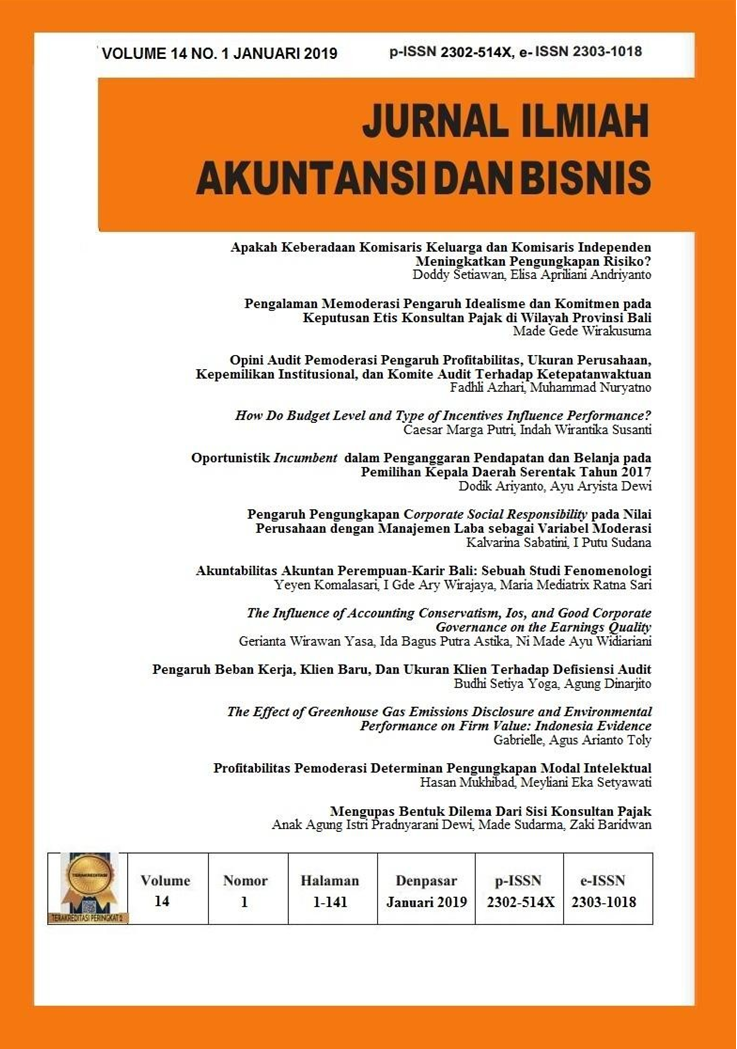Pengaruh Beban Kerja, Klien Baru, Dan Ukuran Klien Terhadap Defisiensi Audit
Abstract
This study aims to examine whether public accountants’ workload, new clients, and size of clients influence the occurrence of audit deficiencies conducted by public accountants on the basis of the data collected by the Finance Professions Supervisory Centre (PPPK), Ministry of Finance. PPPK is given the authority to ensure that the audits carried out by public accountants are in accordance with applicable standards. This is a quantitative research using multiple linear regression analysis of public accountants’ data examined by PPPK from 2013 to 2016. Test results show that only the client size affects the audit deficiencies identified by PPPK in a positive direction. This research is expected to be a resource for public accountants to give proper attention during audits of large clients and help PPPK in determining the examination samples of public accountants each year.
Keywords: audit, audit deficiency, PPPK, public accountant
Downloads
References
Cahan, S. F., & Sun, J. (2015). The Effect of Audit Experience on Audit Fees and Audit Quality. Journal of Accounting, Auditing and Finance, 30(1), 78–100. https://doi.org/10.1177/0148558X14544503.
Carcello, J. V., & Nagy, A. L. (2004). Audit firm tenure and fraudulent financial reporting. Auditing: A Journal of Practice & Theory, 23(2), 55–69.
Chang, C. J., Luo, Y., & Zhou, L. (2017). Audit deficiency and auditor workload: Evidence from PCAOB triennially inspected firms. Review of Accounting and Finance. https://doi.org/10.1108/RAF-03-2017-0050.
Darmiari, N. P. D., & Ulupui, I. G. K. A. (2014). Karakteristik Perusahaan di Bursa Efek Indonesia, Reputasi Kantor Akuntan Publik dan Ketepatwaktuan Pelaporan Keuangan. E-Jurnal Akuntansi Universitas Udayana, 9(1), 38–57.
Deis, D. R., & Giroux, G. A. (1992). Determinants of in Audit Sector Quality the Public. American Accounting Association, 67(3), 462–479.
Deis, D. R., & Giroux, G. A. (1996). The effect of auditor changes on audit fees, audit hours, and audit quality. Journal of Accounting and Public Policy, 15(1), 55–76. https://doi.org/10.1016/0278-4254(95)00041-0.
Dopuch, N., King, R. R., & Schwartz, R. (2001). An experimental investigation of retention and rotation requirements. Journal of Accounting Research. https://doi.org/10.1111/1475-679X.00005.
Febriyanti, N. M. D., & Mertha, M. I. (2014). Pengaruh masa perikatan audit, rotasi KAP, ukuran perusahaan klien, dan ukuran KAP pada kualitas audit. E-Jurnal Akuntansi Universitas Udayana.
Ghozali, I. (2013). Aplikasi Analisis Multivariate dengan Program IBM SPSS 23. Semarang: Badan Penerbit Universitas Diponegoro.
Halim, A., T, S., Rosidi, & Achsin, M. (2014). Effect of competence and auditor independence on audit quality with audit time budget and professional commitment as a moderation variable. International Journal of Business and Management Invention.
Hermanson, D. R., Houston, R. W., & Rice, J. C. (2007). PCAOB inspections of smaller CPA firms: Initial evidence from inspection reports. Accounting Horizons, 21(2), 137–152. https://doi.org/10.2308/acch.2007.21.2.137.
Innayati, C. D., & Susilowati, E. (2015). Pengaruh karakteristik perusahaan dan auditor terhadap audit delay (studi kasus pada perusahaan hotel, restoran, dan pariwisata di Bursa Efek Indonesia). Jurnal Akuntansi, XIX(03), 449–461.
Institut Akuntan Publik Indonesia. (2013a). Standar Audit 220: Pengendalian Mutu untuk Audit atas Laporan Keuangan. Jakarta: Salemba Empat.
Institut Akuntan Publik Indonesia. (2013b). Standar Audit 510: Perikatan Audit Tahun Pertama-Saldo Awal. Jakarta: Salemba Empat.
Jensen, M. C., & Meckling, W. H. (1976). Theory of the firm: Managerial behavior, agency cost and ownership structure. Journal of Financial Economics.
Kafabih, M., & Adiwibowo, A. S. (2017). Analisis pengaruh client size, audit firm size, dan audit fee terhadap audit quality. Diponegoro Journal of Accounting, 6(3), 1–11.
Kang, F., Farag, M., Hurt, R., & Wyrick, C. (2014). The association between PCAOB-identified audit deficiencies and small audit firms’ characteristics: Evidence from PCAOB inspection reports. Managerial Auditing Journal, 29(8), 717–735. https://doi.org/10.1108/MAJ-12-2013-0975.
Linda Elizabeth DeAngelo. (1981). Auditor Size And Audit Quality. Journal of Accounting and Economics, 3 (1981)(North-Holland Publishing Company AUDITOR), 183–199. https://doi.org/10.1021/n10602701.
Liu, L. L., Xie, X., Chang, Y. S., & Forgione, D. A. (2017). New clients, audit quality, and audit partner industry expertise: Evidence from Taiwan. International Journal of Auditing. https://doi.org/10.1111/ijau.12095.
Lobo, G. J., & Zhou, J. (2006). Did conservatism in financial reporting increase after the Sarbanes-Oxley act? initial evidence. Accounting Horizons, 20 Number, 57–73. https://doi.org/10.2308/acch.2006.20.1.57
Maletta, M., & Wright, A. (1996). Audit Evidence Planning: An Examination of Industry Error Characteristics. Auditing: A Journal of Practice & Theory (Vol. 15).
Nindita, C., & Siregar, S. V. (2012). Analisis Pengaruh Ukuran Kantor Akuntan Publik Terhadap Kualitas Audit di Indonesia. Jurnal Akuntansi Dan Keuangan, 14(2), 91–104. https://doi.org/10.9744/jak.14.2.91-104.
Otoritas Jasa Keuangan. (2016). Master Plan Sektor Jasa Keuangan Indonesia 2015-2019. Retrieved from http://www.ojk.go.id/id/berita-dan-kegiatan/publikasi/Documents/Pages/Master-plan-sektor-jasa-keuangan-indonesia-periode-2015-2019/MPSJKI OJK Final_Ind.pdf.
Public Company Accounting Oversight Board. (2006). 2005 Annual Report. Washington, D.C.
Public Company Accounting Oversight Board. (2016). Report on 2015 inspection of KPMG LLP (Headquartered in New York, New York). Washington, D.C.
Public Company Accounting Oversight Board. (2017). 2016 Annual Report. Washington, D.C.
Raiborn, C., Schorg, C. A., & Massoud, M. (2006). Should auditor rotation be mandatory? Journal of Corporate Accounting & Finance, 17(4), 37–49. https://doi.org/10.1002/jcaf.20214.
Setiawan W, L., & Fitriany. (2011). Pengaruh Workload Dan Spesialisasi Auditor Terhadap Kualitas Audit Dengan Kualitas Komite Audit Sebagai Variabel Pemoderasi. Jurnal Akuntansi Dan Keuangan Indonesia, 8(1), 36–53.
Trotman, K. T., & Yetton, P. W. (1985). The effect of the review process on auditor judgments. Journal of Accounting Research, 23(1), 256–267. https://doi.org/10.2307/2490918.




















